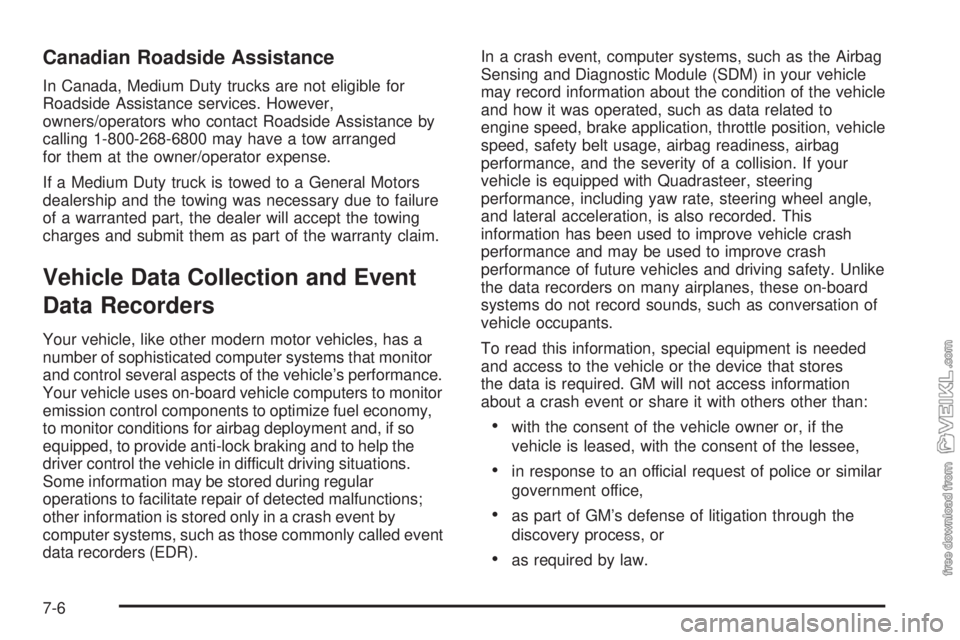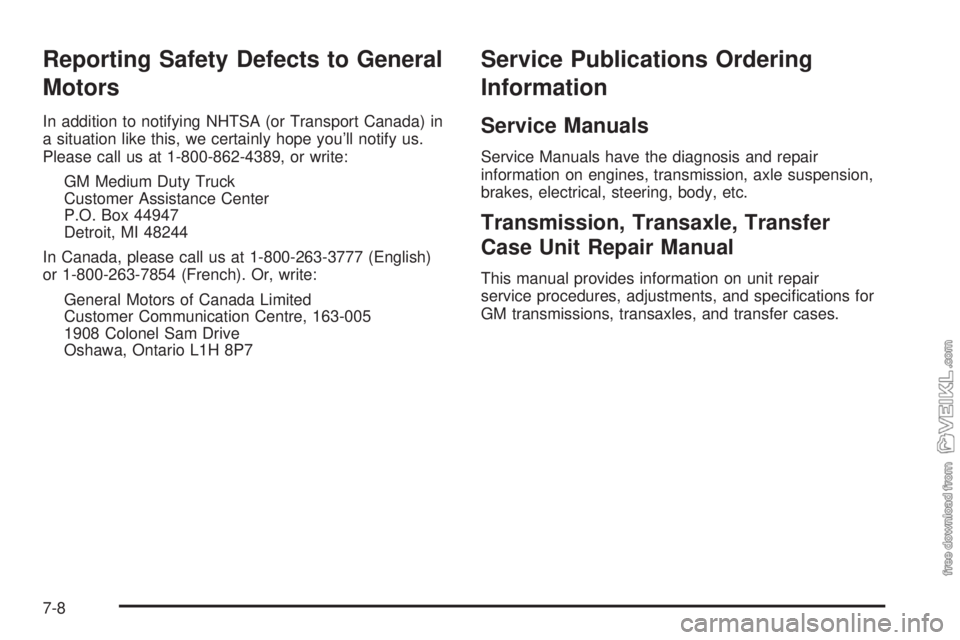2005 CHEVROLET KODIAK brake
[x] Cancel search: brakePage 343 of 374

Starter Switch Check
{CAUTION:
When you are doing this inspection, the
vehicle could move suddenly. If the vehicle
moves, you or others could be injured.
1. Before you start, be sure you have enough room
around the vehicle.
2. Firmly apply both the parking brake and the
regular brakes.
Do not use the accelerator pedal, and be ready to
turn off the engine immediately if it starts.
3. On automatic transmission vehicles, try to start the
engine in each gear. The starter should work only
in PARK (P), if equipped, or NEUTRAL (N). If
the starter works in any other position, your vehicle
needs service. On manual transmission vehicles,
the starter should work only when the clutch pedal is
all the way down.
Automatic Transmission Shift
Indicator Check
Check that the indicator points to the gear chosen.
Steering Check
Be alert for any changes in steering action, abnormal
front tire wear or steering wheel position. An inspection
or service is needed when the steering wheel is
harder to turn or has too much free play, or if there are
strange sounds when turning or parking.
Brake System Check
Be alert to illumination of the low air warning lamp or for
the tone alarm, or changes in braking action, such as
repeated pulling to one side, unusual sounds when
braking or increased brake pedal travel. Make sure air
brake system reservoirs are drained daily with full
system air pressure, and check system for leaks. Any of
these conditions could indicate the need for brake
system inspection and/or service.
6-29
Page 344 of 374

Engine Cooling System Service
Inspect the hoses and have them replaced if they are
cracked, swollen, or deteriorated. Inspect all pipes,
fittings, and clamps; replace as needed. Clean
the outside of the radiator and air conditioning
condenser. To help ensure proper operation, a pressure
test of the cooling system and pressure cap is
recommended at least once a year.
Exhaust System Check
Be alert for any changes in the sound of the exhaust
system or any smell of fumes. These are signs the
system may be leaking. Have it checked and/or repaired
at once. Refer toEngine Exhaust on page 2-43and
Running the Engine While Parked on page 2-44.
Windshield Wipers and Washers Check
Check operation and condition of the wiper blades.
Check the flow of the washer spray.
Defroster Check
Move the control to the defrost symbol and the fan to HI
or the high symbol. Then check the airflow from the
ducts at the inside base of the windshield.
Mirrors and Sun Visors Check
Check that friction joints hold mirrors and sun visors
in place.
Seat Adjuster Check
When adjusting a manual seat, be sure seat adjusters
latch by attempting to move the seat after latching.
Lamps Check
Check panel lighting, warning lights, indicator lights, and
interior lamps. On the outside, check: license plate
lamps, sidemarker lamps, reflectors or lights on outside
mirrors, headlamps, parking lamps, identification and
clearance lamps, taillamps, brake lamps, turn signals,
backup lamps, and hazard warning flashers. Have
headlamp aim checked at once if beams seem
improperly aimed.
Glass, Mirrors, Lamps and/or
Re�ectors Condition Check
Look for broken, scratched, dirty, or damaged glass,
mirrors, lamps, or reflectors that could reduce the view
or visibility or cause injury. Replace, clean or repair
promptly.
6-30
Page 345 of 374

Door Latches Check
Check that doors close, latch, and lock tightly. Check for
broken, damaged, or missing parts that might prevent
tight latching.
Hood Latches Check
Check that the hood closes firmly. Check for broken,
damaged, loose, or missing parts that might prevent
tight latching. Make sure the secondary latch (if
equipped) keeps the hood from opening all the way
when the primary latch is released.
Fluid Leaks Check
Check for fuel, coolant, oil, or other fluid leaks by
looking at the surface beneath the vehicle after it has
been parked for awhile.
Underbody Inspection
Corrosive materials used for ice, snow removal, and
dust control can collect on the underbody. If these
materials are not removed, accelerated corrosion (rust)
can occur on underbody parts such as fuel lines,
frame, floor pan, and exhaust system. At least every
spring, flush these materials from the underbody
with plain water. Take care to clean well any areas
where mud and other debris can collect. Sediment
packed in closed areas of the frame should be loosened
before being flushed.
Engine Cover Check
Check that the cab’s engine cover and seal (if equipped)
are not torn or damaged. Be sure that the cover is
clamped down firmly to the floor.
At Least Once a Year
Key Lock Cylinders Service
Lubricate the key lock cylinders with the lubricant
specified in Part C.
Underbody Flushing Service
At least every spring, use plain water to flush any
corrosive materials from the underbody. Take care to
clean thoroughly any areas where mud and other debris
can collect.
Tractor Protection (Breakaway)
Valve Check
On air brake models, remove, disassemble, clean and
inspect the tractor protection (breakaway) valve.
6-31
Page 346 of 374

Part C: Recommended Fluids and
Lubricants
Fluids and lubricants identified below by name, part
number, or specification may be obtained from
your dealer.
Usage Fluid/Lubricant
Engine Oil
(Gasoline
Engine)Engine oil which meets GM
Standard GM6094M and displays
the American Petroleum Institute
Certified for Gasoline Engines
starburst symbol. GM Goodwrench
®
oil meets all the requirements for
your vehicle. To determine the
proper viscosity for your vehicle’s
engine, see “Engine Oil” in
the Index.
Engine Oil
(DURAMAX
®
Diesel Engine)Engine oil with the letters CI-4 or
CH-4 is best for your vehicle. The
CI-4 or CH-4 designation may
appear either alone or in
combination with other API
designations, such as API CI-4/SL.
These letters show American
Petroleum Institute levels of quality.
To determine the preferred viscosity
for your vehicle’s diesel engine, see
“Engine Oil” in the Index.
Engine Oil
(Caterpillar
®
Diesel Engine)See the Caterpillar
®Operation &
Maintenance Manual for engine oil
recommendations.
Usage Fluid/Lubricant
Engine Coolant
(Caterpillar
®
Diesel Engine)See the Caterpillar
®Operation &
Maintenance Manual for engine
coolant recommendations.
Engine Coolant
(Gasoline
Engine &
DURAMAX
®
Diesel)50/50 mixture of clean, drinkable
water and use only DEX-COOL
®
Coolant. See “Engine Coolant” in
the Index.
Hydraulic Brake
SystemDelco
®Supreme 11 Brake Fluid or
equivalent DOT-3 brake fluid.
Windshield
Washer SolventGM Optikleen
®Washer Solvent.
Clutch Bearing
LubricantClutch Bearing Lubricant
(GM Part No. 12378484 or
equivalent NLGI #3 consistency).
Exhaust Brake
Ball Joint Cap
LubricantHigh-Temperature Grease
(GM Part No. U.S. 1051344, in
Canada 903037) or NLGI #3
consistency.
Power Steering
SystemDEXRON
®-III Automatic
Transmission Fluid. Look for
“Approved for the H-Specification”
on the label.
Manual
Transmission
(Except ZF
6-Speed)Synthetic Manual Transmission Fluid
(GM Part No. U.S. 12345724, in
Canada 10953510).
6-32
Page 356 of 374

Canadian Roadside Assistance
In Canada, Medium Duty trucks are not eligible for
Roadside Assistance services. However,
owners/operators who contact Roadside Assistance by
calling 1-800-268-6800 may have a tow arranged
for them at the owner/operator expense.
If a Medium Duty truck is towed to a General Motors
dealership and the towing was necessary due to failure
of a warranted part, the dealer will accept the towing
charges and submit them as part of the warranty claim.
Vehicle Data Collection and Event
Data Recorders
Your vehicle, like other modern motor vehicles, has a
number of sophisticated computer systems that monitor
and control several aspects of the vehicle’s performance.
Your vehicle uses on-board vehicle computers to monitor
emission control components to optimize fuel economy,
to monitor conditions for airbag deployment and, if so
equipped, to provide anti-lock braking and to help the
driver control the vehicle in difficult driving situations.
Some information may be stored during regular
operations to facilitate repair of detected malfunctions;
other information is stored only in a crash event by
computer systems, such as those commonly called event
data recorders (EDR).In a crash event, computer systems, such as the Airbag
Sensing and Diagnostic Module (SDM) in your vehicle
may record information about the condition of the vehicle
and how it was operated, such as data related to
engine speed, brake application, throttle position, vehicle
speed, safety belt usage, airbag readiness, airbag
performance, and the severity of a collision. If your
vehicle is equipped with Quadrasteer, steering
performance, including yaw rate, steering wheel angle,
and lateral acceleration, is also recorded. This
information has been used to improve vehicle crash
performance and may be used to improve crash
performance of future vehicles and driving safety. Unlike
the data recorders on many airplanes, these on-board
systems do not record sounds, such as conversation of
vehicle occupants.
To read this information, special equipment is needed
and access to the vehicle or the device that stores
the data is required. GM will not access information
about a crash event or share it with others other than:
•with the consent of the vehicle owner or, if the
vehicle is leased, with the consent of the lessee,
•in response to an official request of police or similar
government office,
•as part of GM’s defense of litigation through the
discovery process, or
•as required by law.
7-6
Page 358 of 374

Reporting Safety Defects to General
Motors
In addition to notifying NHTSA (or Transport Canada) in
a situation like this, we certainly hope you’ll notify us.
Please call us at 1-800-862-4389, or write:
GM Medium Duty Truck
Customer Assistance Center
P.O. Box 44947
Detroit, MI 48244
In Canada, please call us at 1-800-263-3777 (English)
or 1-800-263-7854 (French). Or, write:
General Motors of Canada Limited
Customer Communication Centre, 163-005
1908 Colonel Sam Drive
Oshawa, Ontario L1H 8P7
Service Publications Ordering
Information
Service Manuals
Service Manuals have the diagnosis and repair
information on engines, transmission, axle suspension,
brakes, electrical, steering, body, etc.
Transmission, Transaxle, Transfer
Case Unit Repair Manual
This manual provides information on unit repair
service procedures, adjustments, and specifications for
GM transmissions, transaxles, and transfer cases.
7-8
Page 361 of 374

A
Accessory Power Outlets.................................3-19
Adding a Snow Plow or Similar Equipment.........4-34
Adding Equipment to Your Airbag-Equipped
Vehicle.......................................................1-59
Additives, Fuel................................................. 5-6
Add-On Electrical Equipment............................5-88
Air Brake.......................................................2-40
Air Cleaner/Filter, Engine.................................5-33
Air Conditioning..............................................3-20
Air Conditioning System...................................5-70
Air Pressure Gage..........................................3-44
Air Shift Control..............................................2-27
Air Suspension...............................................2-42
Air Suspension Seats........................................ 1-6
Airbag
Off Light.....................................................3-28
Readiness Light..........................................3-27
Airbag Sensing and Diagnostic Module (SDM)...... 7-6
Airbag System................................................1-48
Adding Equipment to Your Airbag-Equipped
Vehicle...................................................1-59
Airbag Off Switch........................................1-56
How Does an Airbag Restrain?......................1-54
Servicing Your Airbag-Equipped Vehicle..........1-59
What Makes an Airbag Inflate?......................1-54
What Will You See After an Airbag Inflates?....1-54Airbag System (cont.)
When Should an Airbag Inflate?....................1-53
Where Are the Airbags?...............................1-52
AM-FM Radio.................................................3-45
Antenna, Fixed Mast.......................................3-59
Anti-Lock Brake System (ABS)........................... 4-6
Anti-Lock Brake, System Warning Light..............3-34
Anti-Lock Brakes, Trailer System
Warning Light.............................................3-34
Appearance Care............................................5-79
Aluminum or Chrome-Plated Wheels..............5-84
Care of Safety Belts....................................5-82
Chemical Paint Spotting...............................5-85
Cleaning Exterior Lamps/Lenses....................5-83
Cleaning the Inside of Your Vehicle................5-80
Fabric/Carpet..............................................5-81
Finish Care.................................................5-83
Finish Damage............................................5-85
Instrument Panel, Vinyl, and Other Plastic
Surfaces.................................................5-82
Sheet Metal Damage...................................5-85
Tires..........................................................5-85
Underbody Maintenance...............................5-85
Vehicle Care/Appearance Materials................5-86
Washing Your Vehicle...................................5-83
Weatherstrips..............................................5-82
Windshield and Wiper Blades........................5-84
Ashtrays........................................................3-20
1
Page 362 of 374

Audio System(s).............................................3-44
AM-FM Radio.............................................3-45
Care of Your Cassette Tape Player................3-58
Care of Your CD Player...............................3-59
Care of Your CDs........................................3-59
Chime Level Adjustment...............................3-59
Fixed Mast Antenna.....................................3-59
Radio with Cassette.....................................3-48
Radio with CD............................................3-53
Setting the Time..........................................3-45
Theft-Deterrent Feature................................3-57
Understanding Radio Reception.....................3-57
Automatic Ether Injection System......................5-68
Automatic Transmission
Fluid..........................................................5-34
Operation...................................................2-28
Axle, Two-Speed Rear Axle Electric
Shift Control...............................................2-26B
Battery..........................................................5-55
Bench Seat, Split............................................. 1-6
Brake
Anti-Lock Brake System (ABS)........................ 4-6
Diesel Engine Exhaust.................................2-25
Emergencies................................................ 4-8
Exhaust Indicator Light.................................3-40
Hydraulic Systems......................................... 4-6
System Warning Light..................................3-31
Trailer Hand Control Valve.............................. 4-8
Brakes..........................................................5-47
Air .............................................................2-40
Hydraulic....................................................2-38
Propshaft Brake Burnish Procedure................2-39
Braking........................................................... 4-5
Braking in Emergencies..................................... 4-8
Break-In, New Vehicle.....................................2-11
Bulb Replacement...........................................5-65
2